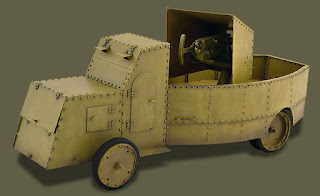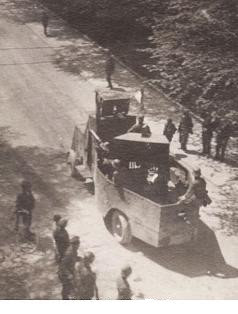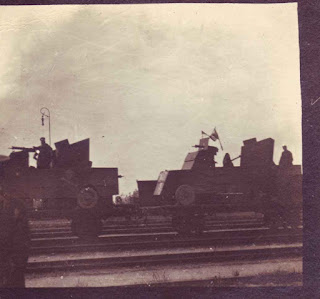
|
|||||||||||||||||||||||||||||||||||||||||||||
L'entreprise Packard :
Packard était une marque automobile américaine fondée en 1899 et qui disparut à la fin des années cinquante. Elle avait la réputation de construire des voitures de luxe de grande qualité et fiabilité mais d'un coup élevé. Cette firme a aussi construit des camions mais ceux ci ont eu peu de succès à cause de leur coût élevé. Les premiers véhicules furent produits à Warren (ohio) sous la marque New York and Ohio Automobile Company puis la firme fut refinancée par un groupe d'investisseurs enchantés de leur achat d'une Packard , renommée Packard motor car company, et relocalisée à Détroit. Packard fabriqua des camions de 1905 à 1923 et en produisit 40 000 en tout. Packard participa à des tests organisés par l'armée américaine en 1909 avec son camion de 3 tonnes qui portait un canon de 3 pounder. Même si ces tests n'aboutirent pas, les performances du camion furent remarquées et l'armée américaine en acquis quelques uns avant le début de la première guerre mondiale. Dès le début de celle ci, Packard augmenta sa production de camions afin de fournir les alliés. En 1915 déjà, Packard fabriquait plus de camions que de voitures. C'est ce camion de 3 tonnes (qui restera quasiment inchangé jusqu'à la fin de la guerre hormis la suppression de la transmission par chaine) à moteur de 32CV qui fut exporté en Russie.
The Packard company:
Packard was an American automobile company founded in 1899 and disappeared in the late fifties. It had the reputation of building luxury cars of high quality and reliability but of a high cost. The firm also built trucks, but these were not very successful due to their high cost. The first vehicles were produced in Warren (Ohio) under the New York and Ohio Automobile Company brand, and the company was refinanced by a group of investors delighted with their purchase of a Packard, renamed Packard Motor Car Company, and relocated to Detroit. Packard manufactured trucks from 1905 to 1923 and produced a total of 40,000 trucks. Packard participated in tests conducted by the US Army in 1909 with his 3-ton truck carrying a 3-pounder gun. Even if these tests did not succeed, the performance of the truck was noticed and the American army acquired some before the beginning of the First World War. From the very beginning, Packard increased its production of trucks to supply the allies. By 1915, Packard was making more trucks than cars. It is this 3-ton truck (which will remain virtually unchanged until the end of the war, except for the suppression of chain transmission) with a 32CV engine that was exported to Russia.
L'auto-canon Packard :
En novembre 1914, suite à l'expérience des premiers combats, il fut décidé de modifier l'organigramme de la 1ère compagnie d'auto-mitrailleuses (voir le chapitre sur l'histoire des auto-mitrailleuses de l'empire russe). L'usine Izhora reçut une commande pour deux véhicules supplémentaires Mannesmann-Mulag sur chassis 3,5 tonnes ainsi que deux véhicules sur chassis Packard de 3 tonnes à moteur de 32CV. Pour plus de simplicité et de rapidité, ces auto-canons vont garder la structure assignée aux précédents véhicules : moteur et cabine blindée, canon sur un plateau arrière.
The Packard self-propelled gun:
In November 1914, following the experience of the first fights, it was decided to modify the organization chart of the 1st company of armored cars (see the chapter on the history of the armored cars of the Russian Empire). The Izhora Factory received an order for two additional Mannesmann-Mulag vehicles on a 3.5-ton chassis as well as two vehicles on a 3-ton Packard chassis with a 32 HP motor. For simplicity and speed, these auto-guns will keep the structure assigned to the previous vehicles: engine and cabin armored, gun on a rear plate.
Histoire :
Cet auto-canon fit partie de la 1ère compagnie d'auto-mitrailleuses créée en octobre 1914 et combattit sur le front nord ouest. La compagnie réorganisée reçut ces véhicules en mars 1915. Ils équipèrent les 2ème et 3ème sections. L'un des deux Packard fut renommé « Capitaine Gourde », en l'honneur du capitaine du même nom, 1er décoré de la compagnie de l'ordre de st George, suite à son combat et à sa mort durant la bataille de dobrzhankovo le 12 février 1915, bataille qui vit aussi la perte de l'unique auto-canon Mannesmann-Mulag du premier type. Les Packard suivirent ensuite les péripéties des combats et transferts de la 1ère compagnie d'auto-mitrailleuses jusqu'à la fin des combats et l'arrivée des Allemands dans la ville de Dvinsk (Daugavpils, Lettonie).
history:
This self-propelled gun was part of the first armored car company created in October 1914 and fought on the northwest front. The reorganized company received these vehicles in March 1915. They equipped the 2nd and 3rd sections. One of the two Packards was renamed "Captain Gourde", in honor of the captain of the same name, 1st decorated with the company of the order of St George, following his fight and his death during the battle of Dobrzhankovo on February 12, 1915, battle that also saw the loss of the only Mannesmann-Mulag auto-cannon of the first type. The Packards then followed the events of the fighting and transfers of the first armored car company until the end of the fighting and the arrival of the Germans in the city of Dvinsk (Daugavpils, Latvia).
l'auto-canon Packard sous les couleurs allemandes :
L'armée allemande prit en compte les deux auto-canons Packards, les seuls véhicules de l'ancienne 1ère compagnie d'auto-mitrailleuses que l'on retrouvera donc à Berlin et Munich par la suite. Ceux-ci furent remis à niveau avec un armement différent : un canon automatique Becker (Becker Tankabwehrkanone 2cm M11) et trois mitrailleuses MG08/15 dont l'une fut montée sur le toit avec un bouclier protecteur. Ces auto-canons seront vus en mars 1919 à Berlin lors de l'écrasement de la seconde révolte spartakiste et à Munich en mai 1919 lors de l'écrasement de la république des conseils de Bavière. Ils sont probablement démentelés en 1920.
The Packard self-propelled gun under the german flag :
The German army took into account the two Packards, the only vehicles of the former 1st armored car company that will be found in Berlin and Munich thereafter. They were refitted with a different armament: an automatic Becker gun (Becker Tankabwehrkanone 2cm M11) and three MG08 / 15 machine-guns, one of which was mounted on the roof with a protective shield. These self-propelled gun were seen in march 1919 in Berlin during the annihilation of the second spartacist rebellion and in may 1919 in Munich during the destruction of the bavarian councils republic. They were probably demented in 1920.
Description technique :
Comme pour les précédents véhicules, seuls le moteur et la cabine furent blindés par plaques de 4mm (côtés, toit) et 5mm (face avant, bouclier canon) d'acier au nickel chrome rivetées sur cornières qui protègent des tirs de fusil à 200m. Comme pour le Mannesmann-Mulag, des trappes de maintenance moteur furent prévues sur les côtés et de refroidissement moteur sur l'avant. Le conducteur était assis à l'avant gauche, le chef de bord à droite. Une large plaque blindée pivotante premettait la conduite et éventuellement le tir par une mitrailleuse. L'accès se faisait par une seule porte côté gauche. Un phare était monté à l'avant au dessus du radiateur. La caisse arrière aux contours arrondis (les Allemands l'appelleront d'ailleurs Panzerei - oeuf blindé) n'était pas blindée et portait l'arme principale. Celle-ci était un canon automatique de marine Maxim Nordenfeldt de 37 mm. Le tir était permis sur un secteur de 300 ° autour de l'arme. L'approvisionnement était de 1200 coups. Cette arme, choisie aussi pour la seconde version des auto-canons Mannsmann-Mulag fut préférée au canon de 47 mm Hotchkiss par sa cadence de tir plus rapide et car sa munition explosive était bien plus adaptée à l'emploi contre personnels. Une seule mitrailleuse Maxim était emportée sans emplacement précis. L'approvisionnement était à 8000 coups en 32 boites standard (250 cartouches). Une charge de 48 kg de TNT était aussi emportée.
Moteur 4 cyl en ligne de 32 CV
vitesse sur route : 50 km/h
chassis 4X2 avec transmission par chaine
poids : 5,760 tonnes
équipage : 7
nbre d'exemplaires construits : 2
Technical description :
As with previous vehicles, only the engine and cab were armored by 4mm (sides, roof) and 5mm (front panel, barrel shield) chrome nickel steel riveted on angle brackets that protect rifle fire at 200m. As for the Mannesmann-Mulag, engine maintenance hatches were provided on the sides and engine cooling on the front. The driver sat at the left front, the chief on the right. A large swivel armored plate allowed the driver to drive and possibly fire with a machine gun. Access was through a single door on the left. A headlight was mounted at the front above the radiator. The rear body with rounded contours (the germans nammed it panzerei -armored egg) was unarmored and carried the main weapon. This was a 37 mm Maxim Nordenfeldt automatic marine gun. Fire was allowed on an area of 300 ° around the weapon. The supply was 1200 shots. This weapon, also chosen for the second version of the Mannsmann-Mulag self-guns, was preferred to the 47 mm Hotchkiss gun because its better rate of fire and its explosive ammunition was much more suitable for use against soldiers. A single Maxim machine-gun was carried away without a precise location. The supply was at 8000 shots in 32 standard boxes (250 cartridges). A load of 48 kg of TNT was also carried.
4 cyl inline engine of 32 hp
Speed on the road: 50 km / h
4X2 chassis with chain drive
Weight: 5,760 tonnes
Crew: 7
|
|
Droit d’auteur La plupart des photographies publiées sur ce site sont la propriété exclusive de © Claude Balmefrezol Elles peuvent être reproduites pour une utilisation personnelle, mais l’autorisation préalable de leur auteur est nécessaire pour être exploitées dans un autre cadre (site web publications etc) Les sources des autres documents et illustrations sont mentionnées quand elles sont connues. Si une de ces pièces est protégée et que sa présence dans ces pages pose problème, elle sera retirée sur simple demande. Principaux Collaborateurs:
Nb
de visiteurs:7067023 Nb
de visiteurs aujourd'hui:1177 Nb
de connectés:66 | |||||||||||||||||||||||||||||||||||||||||||





















